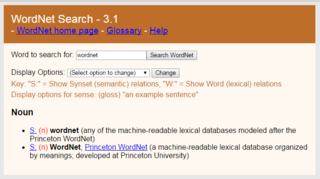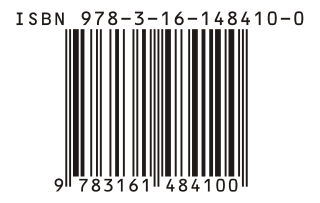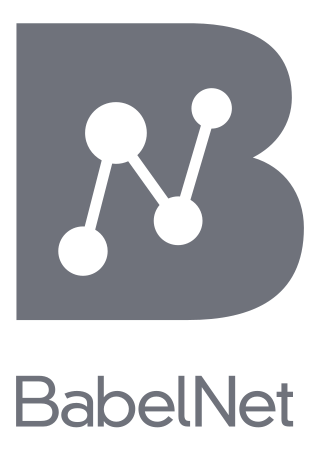Related Research Articles

WordNet is a lexical database of semantic relations between words that links words into semantic relations including synonyms, hyponyms, and meronyms. The synonyms are grouped into synsets with short definitions and usage examples. It can thus be seen as a combination and extension of a dictionary and thesaurus. While it is accessible to human users via a web browser, its primary use is in automatic text analysis and artificial intelligence applications. It was first created in the English language and the English WordNet database and software tools have been released under a BSD style license and are freely available for download from that WordNet website. There are now WordNets in more than 200 languages.

In communications and computing, a machine-readable medium is a medium capable of storing data in a format easily readable by a digital computer or a sensor. It contrasts with human-readable medium and data.

Wiktionary is a multilingual, web-based project to create a free content dictionary of terms in all natural languages and in a number of artificial languages. These entries may contain definitions, images for illustration, pronunciations, etymologies, inflections, usage examples, quotations, related terms, and translations of terms into other languages, among other features. It is collaboratively edited via a wiki. Its name is a portmanteau of the words wiki and dictionary. It is available in 194 languages and in Simple English. Like its sister project Wikipedia, Wiktionary is run by the Wikimedia Foundation, and is written collaboratively by volunteers, dubbed "Wiktionarians". Its wiki software, MediaWiki, allows almost anyone with access to the website to create and edit entries.
A semantic lexicon is a digital dictionary of words labeled with semantic classes so associations can be drawn between words that have not previously been encountered. Semantic lexicons are built upon semantic networks, which represent the semantic relations between words. The difference between a semantic lexicon and a semantic network is that a semantic lexicon has definitions for each word, or a "gloss".
Linguistic categories include
DOGMA, short for Developing Ontology-Grounded Methods and Applications, is the name of research project in progress at Vrije Universiteit Brussel's STARLab, Semantics Technology and Applications Research Laboratory. It is an internally funded project, concerned with the more general aspects of extracting, storing, representing and browsing information.
Computational lexicology is a branch of computational linguistics, which is concerned with the use of computers in the study of lexicon. It has been more narrowly described by some scholars as the use of computers in the study of machine-readable dictionaries. It is distinguished from computational lexicography, which more properly would be the use of computers in the construction of dictionaries, though some researchers have used computational lexicography as synonymous.
Machine-readable dictionary (MRD) is a dictionary stored as machine-readable data instead of being printed on paper. It is an electronic dictionary and lexical database.
Language resource management – Lexical markup framework, produced by ISO/TC 37, is the ISO standard for natural language processing (NLP) and machine-readable dictionary (MRD) lexicons. The scope is standardization of principles and methods relating to language resources in the contexts of multilingual communication.
A multilingual notation is a representation in a lexical resource that allows translation between two or more words.
Knowledge extraction is the creation of knowledge from structured and unstructured sources. The resulting knowledge needs to be in a machine-readable and machine-interpretable format and must represent knowledge in a manner that facilitates inferencing. Although it is methodically similar to information extraction (NLP) and ETL, the main criterion is that the extraction result goes beyond the creation of structured information or the transformation into a relational schema. It requires either the reuse of existing formal knowledge or the generation of a schema based on the source data.
GermaNet is a semantic network for the German language. It relates nouns, verbs, and adjectives semantically by grouping lexical units that express the same concept into synsets and by defining semantic relations between these synsets. GermaNet is free for academic use, after signing a license. GermaNet has much in common with the English WordNet and can be viewed as an on-line thesaurus or a light-weight ontology. GermaNet has been developed and maintained at the University of Tübingen since 1997 within the research group for General and Computational Linguistics. It has been integrated into the EuroWordNet, a multilingual lexical-semantic database.
IndoWordNet is a linked lexical knowledge base of wordnets of 18 scheduled languages of India, viz., Assamese, Bangla, Bodo, Gujarati, Hindi, Kannada, Kashmiri, Konkani, Malayalam, Meitei (Manipuri), Marathi, Nepali, Odia, Punjabi, Sanskrit, Tamil, Telugu and Urdu.

BabelNet is a multilingual lexicalized semantic network and ontology developed at the NLP group of the Sapienza University of Rome. BabelNet was automatically created by linking Wikipedia to the most popular computational lexicon of the English language, WordNet. The integration is done using an automatic mapping and by filling in lexical gaps in resource-poor languages by using statistical machine translation. The result is an encyclopedic dictionary that provides concepts and named entities lexicalized in many languages and connected with large amounts of semantic relations. Additional lexicalizations and definitions are added by linking to free-license wordnets, OmegaWiki, the English Wiktionary, Wikidata, FrameNet, VerbNet and others. Similarly to WordNet, BabelNet groups words in different languages into sets of synonyms, called Babel synsets. For each Babel synset, BabelNet provides short definitions in many languages harvested from both WordNet and Wikipedia.
UBY-LMF is a format for standardizing lexical resources for Natural Language Processing (NLP). UBY-LMF conforms to the ISO standard for lexicons: LMF, designed within the ISO-TC37, and constitutes a so-called serialization of this abstract standard. In accordance with the LMF, all attributes and other linguistic terms introduced in UBY-LMF refer to standardized descriptions of their meaning in ISOCat.
UBY is a large-scale lexical-semantic resource for natural language processing (NLP) developed at the Ubiquitous Knowledge Processing Lab (UKP) in the department of Computer Science of the Technische Universität Darmstadt . UBY is based on the ISO standard Lexical Markup Framework (LMF) and combines information from several expert-constructed and collaboratively constructed resources for English and German.
In natural language processing, linguistics, and neighboring fields, Linguistic Linked Open Data (LLOD) describes a method and an interdisciplinary community concerned with creating, sharing, and (re-)using language resources in accordance with Linked Data principles. The Linguistic Linked Open Data Cloud was conceived and is being maintained by the Open Linguistics Working Group (OWLG) of the Open Knowledge Foundation, but has been a point of focal activity for several W3C community groups, research projects, and infrastructure efforts since then.
Helen Aristar-Dry is an American linguist who currently serves as the series editor for SpringerBriefs in Linguistics. Most notably, from 1991 to 2013 she co-directed The LINGUIST List with Anthony Aristar. She has served as principal investigator or co-Principal Investigator on over $5,000,000 worth of research grants from the National Science Foundation and the National Endowment for the Humanities. She retired as Professor of English Language and Literature from Eastern Michigan University in 2013.
OntoLex is the short name of a vocabulary for lexical resources in the web of data (OntoLex-Lemon) and the short name of the W3C community group that created it.
In linguistics and language technology, a language resource is a "[composition] of linguistic material used in the construction, improvement and/or evaluation of language processing applications, (...) in language and language-mediated research studies and applications."
References
- ↑ SARMA, Shikhar Kr, et al. Building multilingual lexical resources using wordnets: Structure, design and implementation. In: Proceedings of the 3rd Workshop on Cognitive Aspects of the Lexicon. 2012. S. 161-170.
- ↑ Francopoulo, Gil; Bel, Nuria; George, Monte; Calzolari, Nicoletta; Monachini, Monica; Pet, Mandy; Soria, Claudia (2009-03-01). "Multilingual resources for NLP in the lexical markup framework (LMF)" (PDF). Language Resources and Evaluation. 43 (1): 57–70. doi:10.1007/s10579-008-9077-5. ISSN 1574-0218. S2CID 7697316.
- ↑ Cimiano, Philipp; Chiarcos, Christian; McCrae, John P.; Gracia, Jorge (2020), Linguistic Linked Data: Representation, Generation and Applications, Springer International Publishing, pp. 45–59, doi:10.1007/978-3-030-30225-2_4, ISBN 978-3-030-30225-2, S2CID 214148590
- ↑ Cimiano, Phillip; McCrae, John P.; Buitelaar, Paul. "Lexicon Model for Ontologies: Community Report, 10 May 2016 Final Community Group Report 10 May 2016". W3C. Retrieved 6 December 2019.
- ↑ Gil Francopoulo (edited by) LMF Lexical Markup Framework, ISTE / Wiley 2013 ( ISBN 978-1-84821-430-9)